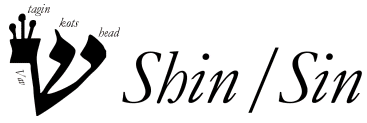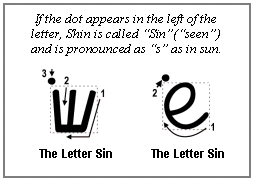
Phonetics
The twenty-first letter of the Hebrew alphabet is called "Shin" (ū®ūüų┤ūÖū¤, pronounced "sheen") and has the sound of "sh" as in "shy."
In modern Hebrew, the letter Shin can appear in three forms:


Manual Print (block)
Write the manual print version (or "block" version) of Shin as follows:
Learn Hebrew


Two strokes are used to create this letter.
Hebrew Script (cursive)
And the cursive version:
Audio Tanakh

This letter looks a little like an English cursive lowercase "e."

Write the letter Shin (from right to left) in both manual print and script several times:
Practice
Hebrew Training

Note: The sole difference between the letter Shin and the letter Sin (pronounced "seen") is the presence or absence of the dot. If a dot appears to the upper right of the letter, pronounce "sh"; if it appears to the left, pronounce "s."
The Letter
Sin

Summary

Note also that some academic Hebrew books use an "s" with a caret on top to transliterate Sin and reserve "s" for Samekh. On this web site, we transliterate both Sin and Samech as "s."
The Four-Headed Shin

The letter Shin appears engraved on both sides of the head tefillin. On the right side, the Shin has three heads, while on the left side it possesses four. If you look closely, it is possible to see an additional three-headed Shin formed from the spaces between the four heads. The three-headed Shin is the Shin of this world, while the four- headed Shin is the Shin of the World to Come.
Advanced Information

Hebrew for Christians
Copyright © John J. Parsons
All rights reserved.